8.3: Polar Form of Complex Numbers
( \newcommand{\kernel}{\mathrm{null}\,}\)
From previous classes, you may have encountered “imaginary numbers” – the square roots of negative numbers – and, more generally, complex numbers which are the sum of a real number and an imaginary number. While these are useful for expressing the solutions to quadratic equations, they have much richer applications in electrical engineering, signal analysis, and other fields. Most of these more advanced applications rely on properties that arise from looking at complex numbers from the perspective of polar coordinates.
We will begin with a review of the definition of complex numbers.
Definition: IMAGINARY NUMBER 
The most basic complex number is
Example
Simplify
Solution
We can separate
A complex number is the sum of a real number and an imaginary number.
Definition: COMPLEX NUMBER
A complex number is a number
Plotting a complex number
We can plot real numbers on a number line. For example, if we wanted to show the number 3, we plot a point:

To plot a complex number like 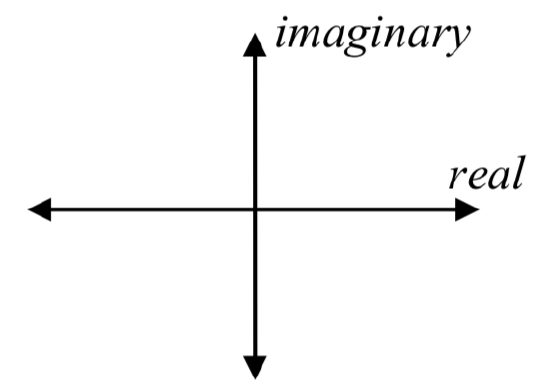 lot this number, we need two number lines, crossed to form a complex plane.
lot this number, we need two number lines, crossed to form a complex plane.
COMPLEX PLANE
In the complex plane, the horizontal axis is the real axis and the vertical axis is the imaginary axis.
Example
Plot the number
Solution
The real part of this number is 3, 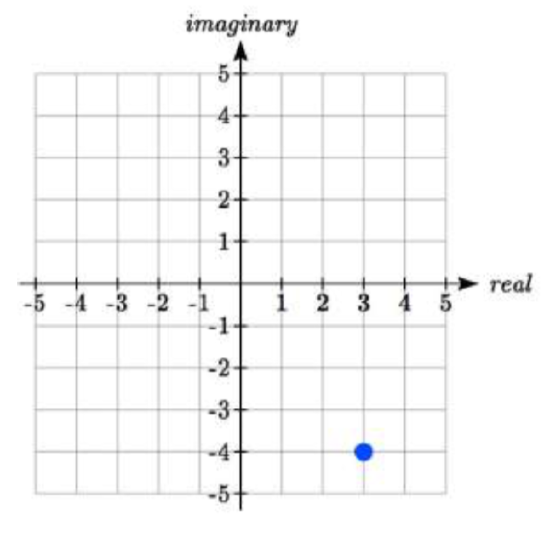 and the imaginary part is - 4. To plot this, we draw a point 3 units to the right of the origin in the horizontal direction and 4 units down in the vertical direction.
and the imaginary part is - 4. To plot this, we draw a point 3 units to the right of the origin in the horizontal direction and 4 units down in the vertical direction.
Because this is analogous to the Cartesian coordinate system for plotting points, we can think about plotting our complex number
Arithmetic on Complex Numbers
Before we dive into the more complicated uses of complex numbers, let’s make sure we remember the basic arithmetic involved. To add or subtract complex numbers, we simply add the like terms, combining the real parts and combining the imaginary parts.
Example
Add
Solution
Adding
Exercise
Subtract
- Answer
-
We can also multiply and divide complex numbers.
Example
Multiply:
Solution
To multiply the complex number by a real number, we simply distribute as we would when multiplying polynomials.
Example
Multiply:
Solution
To multiply two complex numbers, we expand the product as we would with polynomials (the process commonly called FOIL – “first outer inner last”).
Example
Divide
Solution
To divide two complex numbers, we have to devise a way to write this as a complex number with a real part and an imaginary part.
We start this process by eliminating the complex number in the denominator. To do this, we multiply the numerator and denominator by a special complex number so that the result in the denominator is a real number. The number we need to multiply by is called the complex conjugate, in which the sign of the imaginary part is changed. Here,
In the numerator,
Multiplying the denominator
Combining this we get
Exercise
Multiply
- Answer
-
With the interpretation of complex numbers as points in a plane, which can be related to the Cartesian coordinate system, you might be starting to guess our next step – to refer to this point not by its horizontal and vertical components, but using its polar location, given by the distance from the origin and an angle.
Polar Form of Complex Numbers
Remember, because the complex plane is analogous to the Cartesian plane that we can think of a complex number
Bringing in all of our old rules we remember the following: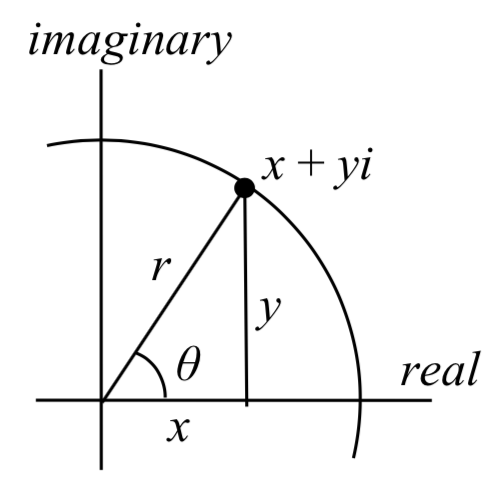
With this in mind, we can write
Example
Express the complex number
Solution
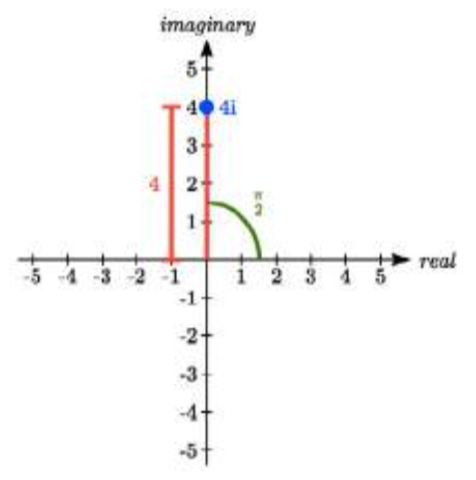 On the complex plane, the number
On the complex plane, the number
Note that the real part of this complex number is 0.
In the
Definition: POLAR FORM OF A COMPLEX NUMBER AND EULER'S FORMULA
The polar form of a complex number is
An alternate form, which will be the primary one used, is
Euler's Formula states
Similar to plotting a point in the polar coordinate system we need
Example
Find the polar form of the complex number -8.
Solution
Treating this is a complex number, we can write it as 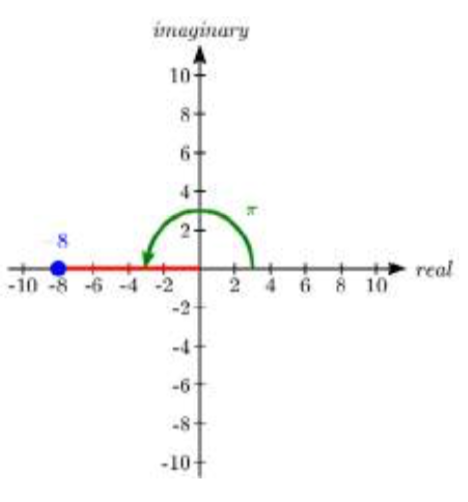
Plotted in the complex plane, the number -8 is on the negative horizontal axis, a distance of 8 from the origin at an angle of
The polar form of the number -8 is
Plugging
Example
Find the polar form of
Solution
On the complex plane, this complex number would correspond to the point (-4, 4) on a Cartesian plane. We can find the distance
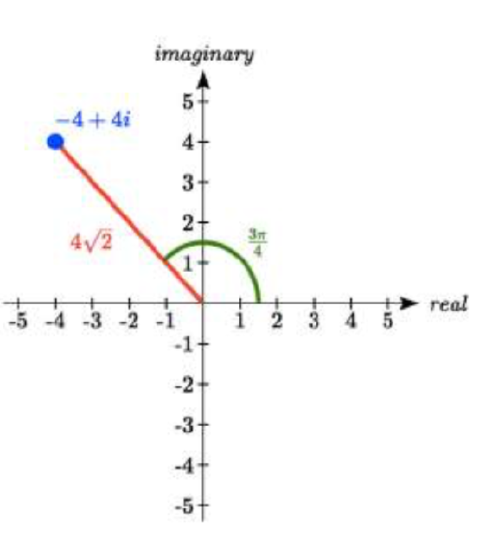
To find
This is one of known cosine values, and since the point is in the second quadrant, we can conclude that
The polar form of this complex number is
Example
Find the polar form of
Solution
On the complex plane, this complex number would correspond to the point (-3, -5) on a Cartesian plane. First, we find

To find
This angle is in the wrong quadrant, so we need to find a second solution. For tangent, we can find that by adding
The polar form of this complex number is
Exercise
Write
- Answer
-
Example
Write
Solution
The polar form of a complex number provides a powerful way to compute powers and roots of complex numbers by using exponent rules you learned in algebra. To compute a power of a complex number, we:
1) Convert to polar form
2) Raise to the power, using exponent rules to simplify
3) Convert back to
Example
Evaluate
Solution
While we could multiply this number by itself five times, that would be very tedious. To compute this more efficiently, we can utilize the polar form of the complex number.
In an earlier example, we found that
At this point, we have found the power as a complex number in polar form. If we want the answer in standard
Since
We have found that
The result of the process can be summarized by DeMoivre’s Theorem. This is a shorthand to using exponent rules.
DEMOIVRE'S THEOREM
If
We omit the proof, but note we can easily verify it holds in one case using Example 12:
Example
Evaluate
Solution
To evaluate the square root of a complex number, we can first note that the square root is the same as having an exponent of
To evaluate the power, we first write the complex number in polar form. Since
Using the polar form, we were able to find a square root of a complex number.
Alternatively, using DeMoivre's Theorem we could write
Exercise
Evaluate
- Answer
-
You may remember that equations like
Similarly, the equation
Example
Find all complex solutions to
Solution
Since we are trying to solve
Since 8 is a real number, is would sit in the complex plane on the horizontal axis at an angle of 0, giving the polar form
However, since the angle
 For the third root, we use the angle of
For the third root, we use the angle of
Altogether, we found all three complex solutions to
Graphed, these three numbers would be equally spaced on a circle about the origin at a radius of 2.
Important Topics of This Section
- Complex numbers
- Imaginary numbers
- Plotting points in the complex coordinate system Basic operations with complex numbers
- Euler’s Formula
- DeMoivre’s Theorem
- Finding complex solutions to equations


